Themed collection 50th anniversary of ICCST: celebrating ICCST at its 15th Edition

50th anniversary of ICCST: celebrating ICCST at its 15th edition
Guest editors Jamal Rafique, Eder J Lenardão and Antonio L. Braga introduce the New Journal of Chemistry themed collection “50th anniversary of ICCST: celebrating ICCST at its 15th edition.”

New J. Chem., 2023,47, 15003-15004
https://doi.org/10.1039/D3NJ90109B
Organic selenocompounds: are they the panacea for human illnesses?
The pharmacological studies of organoselenium compounds need to be profoundly improved to find an actual application of this interesting class of molecules.
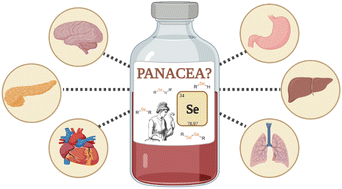
New J. Chem., 2023,47, 9959-9988
https://doi.org/10.1039/D2NJ05694A
Mechanochemistry of dynamic chalcogen-containing polymers: a minireview
This review summarizes recent works about fundamental mechanochemistry research and various applications of mechano-responsive polymers with dynamic chalcogen-containing bonds.

New J. Chem., 2023,47, 5582-5592
https://doi.org/10.1039/D2NJ06196A
Solvent free synthesis of organoselenides under green conditions
Solvent free synthesis of organoselenium compounds using conventional heating, microwave irradiation, ball milling, and photo-induction is discussed.
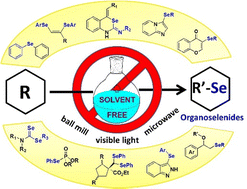
New J. Chem., 2022,46, 21489-21518
https://doi.org/10.1039/D2NJ04068A
Synthesis of 3-selanyl-isoflavones from 2-hydroxyphenyl enaminones using trichloroisocyanuric acid (TCCA): a sustainable approach
We hereby present an original and sustainable synthetic methodology for the synthesis of 3-selanyl-isoflavones from 2-hydroxyphenyl enaminones and diorganoyl diselenides.

New J. Chem., 2023,47, 5598-5602
https://doi.org/10.1039/D2NJ06043D
A new method for creating Se–N intramolecular bonds using UV radiation
Se–N bond formation supported by UV-light.
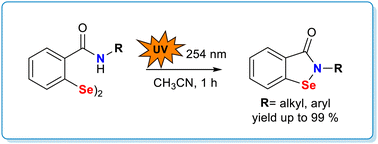
New J. Chem., 2022,46, 20053-20055
https://doi.org/10.1039/D2NJ03513H
Resin-supported cyclic telluride as a heterogeneous promoter of disulfide formation under solid–liquid biphasic conditions
A resin-supported cyclic telluride effectively promoted oxidation of thiols in polypeptides as well as small molecules in a solid–liquid biphasic reaction system, providing the corresponding pure disulfide states without a purification process.
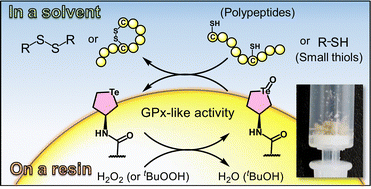
New J. Chem., 2023,47, 18537-18546
https://doi.org/10.1039/D3NJ02646A
Efficient oxyselenation and aminoselenation utilizing a selenenyl iodide based on the characteristic thermodynamics of its reaction with olefins
Using an isolable selenenyl iodide, the characteristic thermodynamics of selenenyl iodide addition to olefins were elucidated and applied to develop the efficient selenofunctionalization of olefins with external oxygen or nitrogen nucleophiles.

New J. Chem., 2023,47, 9569-9574
https://doi.org/10.1039/D2NJ06346H
Ecofriendly aminochalcogenation of alkenes: a green alternative to obtain compounds with potential anti-SARS-CoV-2 activity
We report a solvent- and metal-free methodology for the aminochalcogenation of alkenes, using I2/DMSO as catalytic system, under microwave irradiation. Some of the obtained compounds showed potent antiviral activity against the coronavirus SARS-CoV-2.

New J. Chem., 2023,47, 6591-6601
https://doi.org/10.1039/D2NJ06218F
Arylseleninic acid derivative decomposition towards Se(II)-based electrophiles: an elegant approach to construct 3-selanyl-imidazopyridines
A total of thirty-four 3-selanylimidazopyridines were easily prepared in 50–94% yields using bench stable arylseleninic acids as a selenium source.

New J. Chem., 2023,47, 6066-6072
https://doi.org/10.1039/D2NJ06086H
Thiol modifier effects of diphenyl diselenides: insight from experiment and DFT calculations
A combination of spectroscopic, chromatographic and computational approaches was employed to investigate the reaction of several diselenides with a thiolate nucleophile, leading to the breaking of the selenium–selenium (Se–Se) bond.

New J. Chem., 2023,47, 5796-5803
https://doi.org/10.1039/D2NJ05976B
Synthesis of silver nanoparticles coupled with aromatic diselenides: greener approach, potential against glioma cells and DNA interaction
Synthesis of organochalcogen-modified silver nanoparticles (A1-7), their cytotoxic potentials against glioma cells (C6) & their interaction with DNA.

New J. Chem., 2023,47, 2727-2735
https://doi.org/10.1039/D2NJ04810H
Selenylated indoles: synthesis, effects on lipid membrane properties and DNA cleavage
Selenylated indoles increased the motion rate of the polar region of lipids and ordered the non-polar region, presenting DNA cleavage ability.

New J. Chem., 2023,47, 2719-2726
https://doi.org/10.1039/D2NJ04330K
Silver(I) complexes containing heteroleptic diorganochalcogen(II) ligands
New heteroleptic diorganochalcogen(II) species of type (n-Bu)[4-{2-C6H5-(4H)-oxazol-5-one}C6H4]E (E = Se, S) were synthetized and their ability to coordinate to silver(I) salts was studied.

New J. Chem., 2023,47, 2202-2210
https://doi.org/10.1039/D2NJ05472H
Synthesis of chalcogen-functionalized 4H-chromen-4-ones via cyclization/chalcogenation of alkynyl aryl ketones mediated by Selectfluor®
The selective 6-endo-dig cyclization reaction of alkynyl aryl ketones with electrophilic organochalcogen species in the presence of Selectfluor® is described.

New J. Chem., 2023,47, 1076-1080
https://doi.org/10.1039/D2NJ05567H
Synthesis and biological evaluation of 5-chalcogenyl-benzo[h]quinolines via photocyclization of arylethynylpyridine derivatives
A new method for the synthesis of benzo[h]quinolines 5-chalcogenyl-functionalized via visible light-promoted intramolecular ortho-cyclization was described. Furthermore, studies have suggested that this class of compounds may have promising therapeutic potential.
![Graphical abstract: Synthesis and biological evaluation of 5-chalcogenyl-benzo[h]quinolines via photocyclization of arylethynylpyridine derivatives](/en/Image/Get?imageInfo.ImageType=GA&imageInfo.ImageIdentifier.ManuscriptID=D2NJ04370J&imageInfo.ImageIdentifier.Year=2022)
New J. Chem., 2022,46, 23030-23038
https://doi.org/10.1039/D2NJ04370J
On the coordination behaviour of diorganoselenium ligands based on amino and azole functionalities: silver(I) complexes with relevance for biological applications
[Ag(OTf)L] complexes (L = RR′Se) were prepared, structurally characterized and tested for their in vitro antiproliferative activity.

New J. Chem., 2022,46, 23019-23029
https://doi.org/10.1039/D2NJ04812D
Effectiveness of 7-chloro-4-(phenylselanyl) quinoline in improving learning, short-term memory, and anxiety-like behaviors in a mimetic model of Parkinson's disease in Drosophila melanogaster
The potential of 4-PSQ on psychomotor and non-motor behaviors of PD, such as spontaneous locomotor activity, learning, memory, and anxiety.

New J. Chem., 2022,46, 22539-22549
https://doi.org/10.1039/D2NJ04011E
Unexpected ring closures leading to 2-N,N-dialkylaminoareno[1,3]tellurazoles
One step, up to 78% isolated yield, six examples. Facile access to 2-N,N-dialkylbenzo[1,3]tellurazoles.
![Graphical abstract: Unexpected ring closures leading to 2-N,N-dialkylaminoareno[1,3]tellurazoles](/en/Image/Get?imageInfo.ImageType=GA&imageInfo.ImageIdentifier.ManuscriptID=D2NJ03234A&imageInfo.ImageIdentifier.Year=2022)
New J. Chem., 2022,46, 22533-22538
https://doi.org/10.1039/D2NJ03234A
Synthesis, antioxidant and antitumoral activity of new 5′-arylchalcogenyl-3′-N-(E)-feruloyl-3′, 5′-dideoxy-amino-thymidine (AFAT) derivatives
A new multitarget arylchalcogenyl zidovudine derivative is disclosed. The compounds showed a prominent antioxidant and antitumoral activity with no overt sign of toxicity for in vivo evaluations.
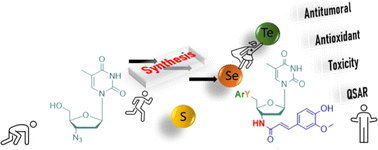
New J. Chem., 2022,46, 22306-22313
https://doi.org/10.1039/D2NJ03487E
An unprecedented non-classical polyinterhalogen anion made of [I2Cl]− and I2 at the 2-(p-tolyl)selenopheno[2,3-b]pyridinium cation template
The H-shaped [I10Cl4]4− polyhalide is the result of the interplay of directional HBs, XBs and π–π interactions driven by the structural features of the 2-(p-tolyl)selenopheno[2,3-b]pyridinium cation template.
![Graphical abstract: An unprecedented non-classical polyinterhalogen anion made of [I2Cl]− and I2 at the 2-(p-tolyl)selenopheno[2,3-b]pyridinium cation template](/en/Image/Get?imageInfo.ImageType=GA&imageInfo.ImageIdentifier.ManuscriptID=D2NJ04689J&imageInfo.ImageIdentifier.Year=2022)
New J. Chem., 2022,46, 21921-21929
https://doi.org/10.1039/D2NJ04689J
Silver-catalyzed synthesis of symmetrical diaryl tellurides from arylboronic acids and tellurium
The synthesis of symmetrical tellurides from different arylboronic acids and elemental tellurium using AgNO3 as a catalyst was performed.

New J. Chem., 2022,46, 21229-21234
https://doi.org/10.1039/D2NJ04019K
Contribution of antioxidant action of 7-chloro-4-(phenylselanyl)quinoline to treat streptozotocin-induced diabetic neuropathy in mice
4-PSQ reduced mechanical and thermal hypersensitivities of diabetic mice by modulation of oxidative stress and glycemic levels.

New J. Chem., 2022,46, 19773-19784
https://doi.org/10.1039/D2NJ02823A
Chalcogen-bonded donor–acceptor complexes of 5,6-dicyano[1,2,5]selenadiazolo[3,4-b]pyrazine with halide ions
With halides X− (X = Cl, Br, I) 5,6-dicyano-[1,2,5]selenadiazolo[3,4-b]pyrazine 1 forms chalcogen-bonded complexes [1–X]− structurally defined by XRD. UV/Vis spectra of [1–X]− feature red-shifted charge-transfer bands in the Vis part.
![Graphical abstract: Chalcogen-bonded donor–acceptor complexes of 5,6-dicyano[1,2,5]selenadiazolo[3,4-b]pyrazine with halide ions](/en/Image/Get?imageInfo.ImageType=GA&imageInfo.ImageIdentifier.ManuscriptID=D2NJ02345H&imageInfo.ImageIdentifier.Year=2022)
New J. Chem., 2022,46, 14490-14501
https://doi.org/10.1039/D2NJ02345H
Synthesis of new chiral N-heterocyclic diselenides and their application in the alkoxyselenylation reaction
Novel chiral diselenides based on a cyclic or bicyclic backbone were applied in the highly diastereoselective methoxyselenylation of styrene.

New J. Chem., 2022,46, 12918-12923
https://doi.org/10.1039/D2NJ01434C
Synthesis and antioxidant activities of N-thiophenyl ebselenamines: a 77Se{1H} NMR mechanistic study
Synthesis of N-thiophenyl ebselenamines and selenenyl sulphides as efficient radical-trapping and hydroperoxide-decomposing antioxidants, respectively has been described.
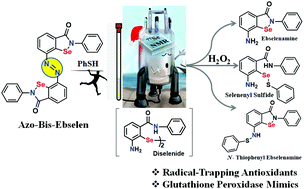
New J. Chem., 2022,46, 12010-12022
https://doi.org/10.1039/D2NJ01225A
Ugi and Passerini reactions enable the incorporation of ΔAA into N-alkylated peptides and depsipeptides
Isocyanide-based multicomponent reactions enable the incorporation of different dehydroamino acids under mild conditions.

New J. Chem., 2022,46, 11502-11509
https://doi.org/10.1039/D2NJ01545E
Unravelling the molecular interaction of diselenodipropionic acid (DSePA) with human serum albumin (HSA)
DSePA, a pharmacologically efficient selenium compound shows strong binding with extracellular carrier protein, Human Serum Albumin.

New J. Chem., 2022,46, 10560-10567
https://doi.org/10.1039/D2NJ01443B
Assessing the effects of covalent, dative and halogen bonds on the electronic structure of selenoamides
The C–NMe2 bond rotation of a selenoamide is proposed as an experimental probe to compare different chemical interactions.

New J. Chem., 2022,46, 10568-10576
https://doi.org/10.1039/D2NJ01421A
Exploring the reactivity of L-tellurocystine, Te-protected tellurocysteine conjugates and diorganodiselenides towards hydrogen peroxide: synthesis and molecular structure analysis
The synthesis of a series of novel organotellurium species and diorganoselenones is reported.

New J. Chem., 2022,46, 10550-10559
https://doi.org/10.1039/D2NJ00997H
About this collection
Considering the growing interest on selenium Se and tellurium Te chemistry among the scientific community in the 20th century, Wolfgang H. H. Gunther and Yoshiyuki Okamoto planned in 1970 to provide a unique platform to the scientific community by organizing the first edition of International Conference on the Chemistry of Selenium and Tellurium (ICCST) that was held in New York. Since the first edition of ICCST, the state of the art on the chemistry of Se and Te regarding organic, inorganic, materials science, theoretical, spectroscopy, biochemistry, agriculture and environmental aspects are featured in its editions.
In 2022, ICCST celebrated its 50th anniversary at its 15th edition was held in Brazil. The event was successful with one hundred and ninety participants throughout the globe that were gathered in Florianópolis, the state capital of Santa Catarina, Brazil. Researchers from Brazil, Japan, Italy, Germany, Slovenia, Denmark, Korea, Romania, Canada, India, Poland, Argentina, Russia, and USA presented their most recent results in the chemistry, biochemistry, agriculture and environmental science of Se and Te compounds. The event involved 22 flash presentations (young researchers and PhD students), 30 oral presentations (plenary, invited and short ones), and 165 posters were presented. A large number of the works presented in the 15th edition of ICCST has been published in the Royal Society of Chemistry (RSC) journals.
This thematic web collection of New Journal of Chemistry (NJC) will compile all aspects of the chemistry of Se and Te in order to provide an updated snapshot of the ongoing quest on these two extraordinary elements as multidisciplinary science. Besides offering unique opportunities of interactions of researchers working in different areas, it will celebrate ICCST as a recognized platform of discussion.
This theme collection, Guest Edited by Jamal Rafique, Eder J. Lenardão, and Antonio L. Braga, contains papers published after the last edition of ICCST in Italy (in 2019) by the scientific community who have actively participated in ICCST, and new papers published in NJC and in other RSC journals since 2021.